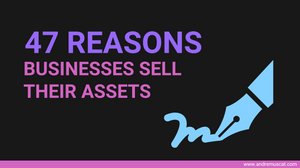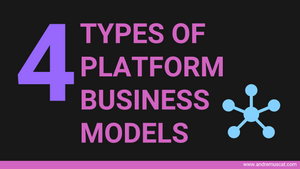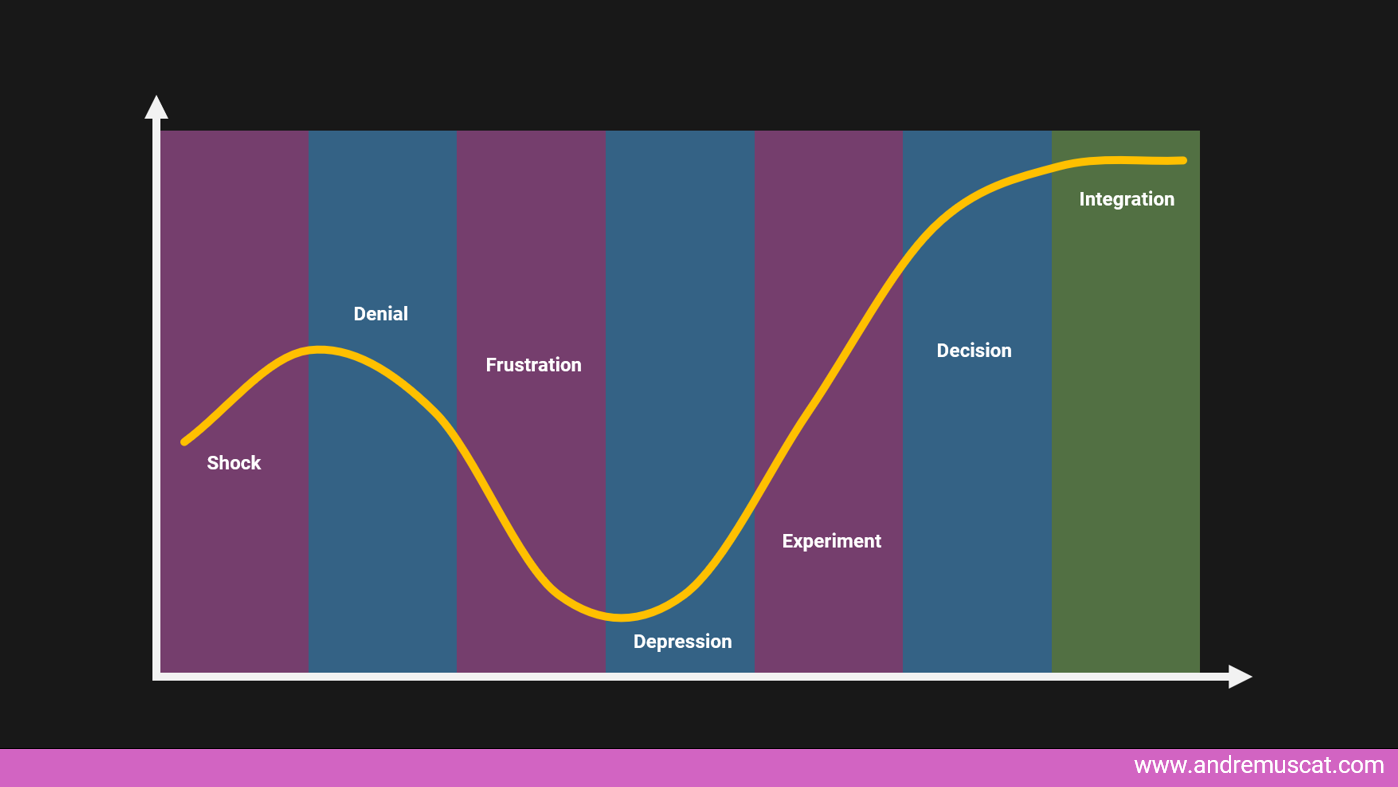Change is unavoidable, "expected" and happens for a variety of reasons:
- Personal challenges of life - some small, some massive, some we want to speak about, and others we may feel better not to speak about.
- Experiments to assess new opportunities
- Current way of operating is unsustainable
- Strategic re-organisations
- Mergers and acquisitions
Change forces us to re-evaluate our priorities and how we can continue having the most impact and relevance in our world - potentially extending it to the economy, technology, society and the environment.

Dealing with change comes with a lot of uncertainty, generally fueled by a personal sense of:
- Guilt
- Fear of success
- Fear of others' judgement
- Fear of failure
- Fear of new unknowns
- Fear of rejection
- Fear of loneliness
- Self-doubt
- Fear of loss (of responsibility, freedom, control, or power)
In times of change, it is critical for you to be able to be continually aware of how this impacts yourself and your team.
Only equipped with this awareness will you be able to navigate such change with serenity, confidence and competence.

NOTE: This need for awareness, applies both whether:
- You are the leader of the team
- You are a member of the team.
In either case:
- Your leader may need help and support
- Your team members may need help and support beyond that that the leader may provide
However, it would not be me if we did not assess the situation based on a formula. One of the most applicable is known as the "Kubler-Ross" change curve.
Introduction to the Kubler-Ross" change curve.
The Kubler-Ross change curve is a model that describes the emotional stages that individuals experience when dealing with change and transition. The model comprises of key stages: denial, frustration, depression, experiment, decision and integration.

Let's explore how
- How you can use this model to understand, predict, and link the reactions of your teams. Use this to support better and manage their emotional reactions to change.
- How you as an individual can better communicate and collaborate with your leader based on what you are experiencing.
Use this model to eliminate unnecessary friction in communication and facilitate everyone to focus on what matters the most to stakeholders to enable change to happen in a way that is supported and promoted by those same stakeholders.

| Stage | Notes/State | Feelings | Support |
| Denial | Status Quo. After the initial ‘shock’ of being confronted with a change, people often resist engaging with change, as if trying to prove that the change is either unreal or unnecessary. | Shock, disbelief, avoidance, resistance | Facilitate alignment. Communicate the change clearly and honestly, explain the reasons and benefits, provide facts and evidence |

| Stage | Notes/State | Feelings | Support |
| Frustration | Anger. Those experiencing the change can no longer avoid engaging with it, often giving way to anger, blame and self-blame. The idea that ‘it’s not fair’ may take hold. Mood and performance tends to decline further with a visible drop in productivity and an increase in passive-aggressive disruption. |
Fear, uncertainty, doubt, frustration, blame, resentment, Hope, compromise, negotiation, guilt This phase can also be characterised by a burst of additional energy (Typically manifesting as excessively noisy resistance). Look for signs of wrinkling of the forehead, squinting eyes, lip compression, avoidance of eye contact, tone of voice in meetings, emails, avoidance of responsibilities, adherence to deadlines |
This is a time for empathy and for helping people to consider the impact these changes will realistically have on them as individuals. Don’t try to minimise the losses people will experience – they need to know that the cost of the change to them is well understood. Maximise communication. Watch, listen, acknowledge and validate their emotions. Listen empathetically, ask coaching questions, and avoid at all costs the desire to solutioneer. This is their journey, and they need to go through it This is a time to listen actively. Avoid arguments or criticism, and provide outlets for expression. Encourage feedback and suggestions, involve them in additional decision-making, offer incentives or rewards, address concerns and objections |

| Stage | Notes/State | Feelings | Support |
| Depression | The journey to this point was characterised by a drive to hold on to, or to revert to, the past state. Energy, morale and performance may fluctuate, but all relate to the ‘downswing’ side of the curve. The realisation that all such efforts to resist this change are failing leaves people at their lowest point of performance, energy and morale. | Confusion, sadness, loss, grief, apathy, withdrawal | Spark motivation. Empathy, active listening, effective support structures are necessary through this phase. Show compassion and support, offer counselling or coaching, recognise achievements and efforts, and provide training or mentoring. This may need multiple touch-points, and a lot of your time. If you cannot dedicate this time, you will fail to achieve the desired outcomes to the desired states. You need to invest to enable people to advance to where you want them to get to |

| Stage | Notes/State | Feelings | Support |
| Experiment | People begin to engage in problem-solving behaviours, allowing them to try out new approaches, suggest improvements | Encourage, support, listen, react to ideas, share knowledge, repeat | |
| Decision & Integration | The eventual integration of these into new ways of operating into their new way of being. | Rebuilding, Commitment, Celebration |
Remember!
Be mindful of factors that tend to affect the length and depth of the personal change curve and the probability of emerging successfully on the upside, including:
- How much control or influence people feel they have over the change. Involving people in the decision of change as early as possible and as deeply as possible significantly improves the prospects for successful change
- The level of emotional and technical support that may be demanded of you or the environment.
- The personal confidence and resilience of the individual.
- How deeply an individual is affected by the change. It is critical to be able to understand and engage in the details of how this change impacts others
- The scale of the change you are representing to their sense of normality.
Share this model with your teams
We are all human, and we deal with emotional aspects every day of our lives. We may not realise changes in our self-emotional state. Share this model with your team, and enable meaningful, better and deeper conversations.
Examples
Here are several scenarios where this model can be used to engage and navigate difficult situations:
Scenario 1: New technology systems
You are implementing a new software system that will replace the old one in the organisation. Use the change curve to anticipate and address people’s emotional reactions. For example, you can communicate the benefits and rationale of the new system, listen to their concerns and feedback, involve them in the testing and training process, provide support and recognition, and celebrate the successful adoption of the new system.
Scenario 2: New M&A activities
Scenario 2: You are leading a team through a merger or acquisition that will result in organisational restructuring and layoffs. Some employees may feel anxious and uncertain about their future. Use the change curve to empathise and support their emotional needs. For example, you can share honest and timely information, acknowledge their feelings and fears, offer career counselling or coaching, recognise their contributions and achievements, help them adjust to the new culture and environment, or even support them in finding a new workplace.
Scenario 3: Personal Crises
Scenario 3: A person in your team faces a personal crisis that affects their performance and well-being. Your team may notice a change in their behaviour and attitude. Use the change curve to manage their own emotions and maintain trust and credibility with them and the team. Suppose you are the one going through the change. In that case, you can admit to your own vulnerability, seek professional help or guidance, delegate tasks or responsibilities, express gratitude and appreciation, and focus on positive outcomes and opportunities.
Scenario 4: Cancellation of Projects
Scenario 4: A team member is informed that their project will be cancelled due to budget cuts, and they will be assigned to a different project. They themselves can use the change curve to recognise and manage their own feelings and enable better communication with you. For example, they can seek clarification and information about the reasons for the cancellation, express their frustration and disappointment, explore other options or opportunities, seek support from their colleagues or manager, and embrace the new project with a positive attitude.
Scenario 5: Learning New Mechanisms
Scenario 5: A team member is required to learn a new software system that will replace the old one. They can use the change curve to identify their state changes, overcome their resistance, and adapt. For example, they can acknowledge the benefits and challenges of the new system, voice their concerns and feedback, participate in the testing and training process, ask for better help or guidance, and practice and improve their skills.
Keep it real!
While this model helps you align people through the change process, the reality is that not everyone will embrace and integrate. Appreciating that you have done everything you could to eliminate blockers, clarify situations etc, it may still be necessary to accept that some people will never accept the change.

If this is the case, and their feedback is no longer reasonably actionable, it is essential to minimise the negative impact of their resistance on the rest of the organisation. This may involve
- Having tougher conversations
- Moving them to different roles or even
- Accepting their resignation while making the transition as smooth as possible in the face of more change.
- Letting them go.
Remember that change is a process, not an event. It takes time for people to adapt to new ways of doing things. It is essential to be patient and persistent and to be willing to make adjustments as needed.
Change is not always easy, but it is often necessary for organisations to succeed. By understanding the reasons for resistance to change and taking steps to overcome it, leaders can increase the chances of success for their change initiatives, which actually leaves me with the biggest lesson I ever learned in each of these cycles....
There are always surprises beyond expectations!:
- There are the ones who you thought would be the highest performers that become the ones who will let you down the most, if not give up in their entirety!.
- There are the ones who you thought would be the lowest performers, only to find them becoming the strongest as a result of the removal of "hidden chains" from the legacy processes that were holding them back.
- Most will go through the "Kubler-Ross" change curve journey and need your help through it.
Trust in people, and believe in their best side....and of course...Trust, but verify!!






